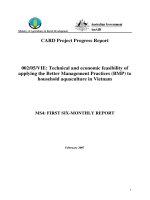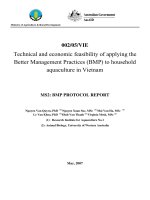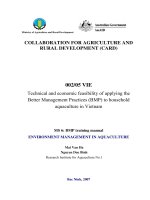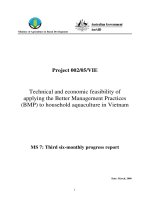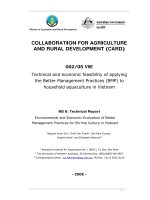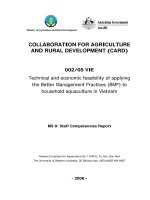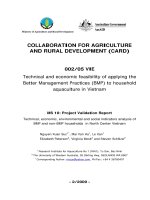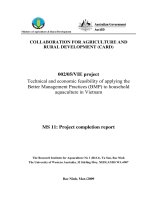How inversion should be introduced to high schoolers in vietnam
Bạn đang xem bản rút gọn của tài liệu. Xem và tải ngay bản đầy đủ của tài liệu tại đây (941.76 KB, 74 trang )
BỘ GIÁO DỤC VÀ ĐÀO TẠO
TRƯỜNG ĐẠI HỌC DÂN LẬP HẢI PHÒNG
-------------------------------
ISO 9001 :2008
KHÓA LUẬN TỐT NGHIỆP
NGÀNH: NGOẠI NGỮ
Sinh viên
: Lê Thị Bách
Giảng viên hướng dẫn: ThS. Nguyễn Thị Huyền
HẢI PHÒNG - 2017
BỘ GIÁO DỤC VÀ ĐÀO TẠO
TRƯỜNG ĐẠI HỌC DÂN LẬP HẢI PHÒNG
-----------------------------------
HOW INVERSION SHOULD BE INTRODUCED
TO HIGH SCHOOLERS IN VIETNAM
KHÓA LUẬN TỐT NGHIỆP ĐẠI HỌC HỆ CHÍNH QUY
NGÀNH: NGOẠI NGỮ
Sinh viên
: Lê Thị Bách
Lớp
: NA1702
Giảng viên hướng dẫn : ThS. Nguyễn Thị Huyền
HẢI PHÒNG - 2017
BỘ GIÁO DỤC VÀ ĐÀO TẠO
TRƯỜNG ĐẠI HỌC DÂN LẬP HẢI PHÒNG
--------------------------------------
NHIỆM VỤ ĐỀ TÀI TỐT NGHIỆP
Sinh viên:
LÊ THỊ BÁCH
Mã SV:
1312751070
Lớp:
NA1702
Ngành:
Ngoại Ngữ
Tên đề tài: How inversion should be introduced to high schoolers in
Vietnam
NHIỆM VỤ ĐỀ TÀI
1. Nội dung và các yêu cầu cần giải quyết trong nhiệm vụ đề tài tốt
nghiệp
(về lý luận, thực tiễn, các số liệu cần tính toán và các bản vẽ).
……………………………………………………………………………..
……………………………………………………………………………..
……………………………………………………………………………..
……………………………………………………………………………..
……………………………………………………………………………..
……………………………………………………………………………..
2. Các số liệu cần thiết để thiết kế, tính toán.
……………………………………………………………………………..
……………………………………………………………………………..
……………………………………………………………………………..
……………………………………………………………………………..
……………………………………………………………………………..
3. Địa điểm thực tập tốt nghiệp.
……………………………………………………………………………….…
…..…………………………………………………………………………...…
……………..…………………………………………………………..….……
……………..…………………………………………………………..…….…
………..…..…………………..…………………..………………….…………
CÁN BỘ HƯỚNG DẪN ĐỀ TÀI TỐT NGHIỆP
Người hướng dẫn thứ nhất:
Họ và tên: NGUYỄN THỊ HUYỀN
Học hàm, học vị: Thạc sỹ
Cơ quan công tác: Trường Đại học dân lập Hải Phòng
Nội dung hướng dẫn: How inversion should be introduced to high
schoolers in Vietnam.
Người hướng dẫn thứ hai:
Họ và tên:.............................................................................................
Học hàm, học vị:...................................................................................
Cơ quan công tác:.................................................................................
Nội dung hướng dẫn:............................................................................
Đề tài tốt nghiệp được giao ngày
tháng
Yêu cầu phải hoàn thành xong trước ngày
Đã nhận nhiệm vụ ĐTTN
Sinh viên
năm
tháng năm
Đã giao nhiệm vụ ĐTTN
Người hướng dẫn
Hải Phòng, ngày ...... tháng........năm 2017
Hiệu trưởng
GS.TS.NGƯT Trần Hữu Nghị
PHẦN NHẬN XÉT CỦA CÁN BỘ HƯỚNG DẪN
1. Tinh thần thái độ của sinh viên trong quá trình làm đề tài tốt
nghiệp:
……………………………………………………………………………..
……………………………………………………………………………..
……………………………………………………………………………..
……………………………………………………………………………..
……………………………………………………………………………..
2. Đánh giá chất lượng của khóa luận (so với nội dung yêu cầu đã đề ra
trong nhiệm vụ Đ.T. T.N trên các mặt lý luận, thực tiễn, tính toán số
liệu…):
……………………………………………………………………………..
……………………………………………………………………………..
……………………………………………………………………………..
……………………………………………………………………………..
……………………………………………………………………………..
3. Cho điểm của cán bộ hướng dẫn (ghi bằng cả số và chữ):
……………………………………………………………………………..
……………………………………………………………………………..
……………………………………………………………………………..
Hải Phòng, ngày … tháng … năm 2017
Cán bộ hướng dẫn
(Ký và ghi rõ họ tên)
NHẬN XÉT ĐÁNH GIÁ
CỦA NGƯỜI CHẤM PHẢN BIỆN ĐỀ TÀI TỐT NGHIỆP
1. Đánh giá chất lượng đề tài tốt nghiệp về các mặt thu thập và phân tích
tài liệu, số liệu ban đầu, giá trị lí luận và thực tiễn của đề tài.
.................................................................................................................................
.................................................................................................................................
.................................................................................................................................
.................................................................................................................................
.................................................................................................................................
.................................................................................................................................
.................................................................................................................................
.................................................................................................................................
.................................................................................................................................
2. Cho điểm của người chấm phản biện: …………………………………..
(Điểm ghi bằng số và chữ)
Ngày......... tháng......... năm 2017
Người chấm phản biện
TABLE OF CONTENTS
ABBREVIATIONS
ACKNOWLEGMENTS
PART 1: INTRODUCTION.................................................................... 1
1.
Rationale .......................................................................................... 1
2.
Aims of the study ............................................................................. 1
3.
Methods of the study....................................................................... 2
4.
Scope of the study............................................................................ 2
5.
Design of the study .......................................................................... 2
PART 2: DEVELOPMENT .................................................................... 4
CHAPTER 1: LITERATURE REVIEW .......................................................... 4
1.1
Teaching methods ........................................................................... 4
1.1.1
Teaching concepts ............................................................................. 4
1.1.2
Teaching grammar methods.............................................................. 5
1.1.2.1
Teaching grammar through structures, rules and examples ............. 5
1.1.2.2
Teaching grammar through visual aids ............................................. 5
1.1.2.3
Teaching grammar through practicing.............................................. 6
1.1.3
Inductive method .............................................................................. 6
1.2
Sentence............................................................................................ 9
1.2.1
Sentence structures............................................................................ 9
1.2.2
Word order ...................................................................................... 10
1.2.3
Verbs ............................................................................................... 11
1.2.3.1
Ordinary verbs ................................................................................ 11
1.2.3.2
Auxiliary verbs................................................................................ 11
1.3
Inversion ........................................................................................ 12
1.3.1
Definition ........................................................................................ 12
1.3.2
Types of inversion........................................................................... 14
1.3.2.1
Subject-auxiliary inversions ........................................................... 14
1.3.2.2
Subject-verb inversion .................................................................... 17
1.4
Summary ........................................................................................ 19
CHAPTER 2: SURVEY IN KIEN THUY HIGH SCHOOL ......................... 21
2.1
Introduction ................................................................................... 21
2.1.1
Kien Thuy High School .................................................................. 21
2.1.2
Participants ...................................................................................... 21
2.2
Methodology .................................................................................. 21
2.2.1
The purposes of survey ................................................................... 21
2.2.2
The design of the survey questionnaire .......................................... 22
2.3
Data and analysis .......................................................................... 22
2.4
Findings and discussion ................................................................ 23
2.4.1
Findings ........................................................................................... 23
2.4.2
Discussion ....................................................................................... 25
2.5
Summary ........................................................................................ 26
CHAPTER 3: TEACHING INVERSION IN KIEN THUY HIGH SCHOOL:
SOME INSTRUCTIONAL STRATEGIES AND IMPLICATIONS ............ 27
3.1
Techniques to introduce inversion theory .................................. 27
3.1.1
Techniques to introduce definition of inversion ............................. 27
3.1.2
Techniques to introduce the function of inversion ......................... 28
3.1.3
Techniques to introduce types of inversion .................................... 28
3.1.4
Techniques of practice .................................................................... 32
3.1.4.1
Communication activities ............................................................... 32
3.1.4.2
Mini game ....................................................................................... 34
3.2
Implication of inversion in Vietnamese equivalences ................ 37
3.3
Summary ........................................................................................ 42
PART 3: CONCLUSION ...................................................................... 44
1.
Limitations of this study ............................................................... 44
2.
Conclusion ..................................................................................... 44
REFERENCES .......................................................................................... 46
APPENDIX 1: Survey questionnaires ........................................................ 47
APPENDIX 2: Rewriting............................................................................ 50
APPENDIX 3: Multiple choices ................................................................ 51
APPENDIX 4: Translating sentences......................................................... 53
APPENDIX 5: Practice at home ................................................................. 54
APPENDIX 6: Handout ............................................................................. 59
APPENDIX 7: Translating some set expressions ...................................... 61
ABBREVIATIONS
S
Subject
O
Object
A
Adverbial
Aux
Auxiliary
p.
Page
ACKNOWLEDGEMENTS
I have received many assistance, support and care of my lectures, family
and friends during the process of graduation paper.
Firstly, I would like to express my gratitude to Haiphong Private
University, Dr. Tran Thi Ngoc Lien – Dean of Haiphong Private University
and Leading of Foreign Languages Department for giving me a chance and
useful ideas to do and complete this study. I would like to thank all my
lectures who supplied and enriched my knowledge during four years at
Haiphong Private University.
Secondly, I would like to send my deepest thanks to my supervisor Ms.
Nguyen Thi Huyen, M.A. Her advice, instruction, materials and correction
have helped me have right orientation and fulfill this study.
Thirdly, I warmly thank for the managers of the iShare English center
where I had internship, and then I work in gave favorable condition and
necessary assistance to me.
Fourthly, I want to thank for high school students in Kien Thuy High
School who took part in my survey questionnaire enthusiastically. Thanks to
their participation, I had data survey, analysis and gave the appropriate
teaching methods.
Lastly, I would like to send sincere thanks to my family and friends who
are always with me, give me encouragement and discussion during the thesis
period.
Haiphong, June, 2017
Student:
Le Thi Bach
PART 1: INTRODUCTION
1.
Rationale
English is considered an international language and a key to approach
the human beings’ knowledge. English subject is not only taught in all most
of schools in Vietnam in all levels but also a way of communication in
economic integration context. Learning English, however, is not easy for
everyone. The education in Vietnam has dramatically changed recently by
educational reforms. The learners are centered-approach, and the teachers are
instructors helping their students acknowledge more effectively. The
educational reforms have achieved some success. However, the teaching
methods for each unit in education in Vietnam especially in high school have
some demerits. I have been a tutor for over two years, I am aware of the
difficulties my students encountered. I have made efforts in how to teach
them better and more effectively. How to teach grammar especially how to
teach English inversion for high students is a question for researchers,
educationalists and teachers. This thesis “How inversion should be introduced
to high schoolers in Vietnam” is studied and analyzed in purpose of
supporting teachers in teaching inversion in high school.
2.
Aims of the study
My aims of the study are to give some strategies for teachers when they
teach inversion in high school. Because the ultimate goal is students, teachers
will guide and instruct their students so that they approach and be able to do
inversion exercises better and use inversion more flexibly in translation.
When students can translate a foreign language into your mother tongue, they
are excited and remember it easily, comprehend the lesson deeply and use it
in other skills such as speaking, writing or reading. One more important
creates the interest and passion in learning grammar of students. Normally,
many students who were interviewed, had the same answer “Grammar is so
1
boring”. Through this study, teachers can innovate the teaching methods more
and more.
3.
Methods of the study
In order to attain the primary aims of this paper, the following steps are
implemented. First, I collected books, references and documents related to
English grammar, teaching methods and inversion. Besides, the available
theories and graduation papers concerned teaching methods and inversion are
selected. All theories have been carefully gathered through reference books
and documents on the internet websites as well.
In addition, in chapter two, a survey was conducted for high schoolers in
Kien Thuy High School about the teaching methods, their attitude and ability
in inversion lesson. A survey questionnaire has been designed as the key data
collection method of teaching of the study. Collecting and analysis have been
used.
4.
Scope of the study
English grammar is diverse, but in this paper I focus on the methods of
teaching inversion and the combination with translation and communication.
Because of the limited time and lack of experience and knowledge, I study
inversion in a sentence, not in a paragraph. This is a relatively broad topic for
me so I pay attention to a school – Kien Thuy High School because the
syllabus of a state high school is similar with the syllabus of ministry of
education and training.
5.
Design of the study
This study is designed in three parts. Part 1 is introduction which
presents the rationales, aims, methods, scope and design of the study. Part 2 is
development consisting of three chapters. Chapter one is theoretical
background of teaching methods and inversion which provide basic
knowledge and related relationship. Chapter two is survey. I take a survey in
Kien Thuy High school to examine the methods of teaching inversion and the
interest and ability of students when they learn and do inversion exercises.
2
From the survey data, I will give results and analysis, findings and discussion.
Chapter three is some instructional strategies for teaching inversion and some
implications of inversion in translation. Part 3 is conclusion which
summarizes all presented information above.
3
PART 2: DEVELOPMENT
CHAPTER 1: LITERATURE REVIEW
1.1
Teaching methods
When I introduce English inversion, I hope the teachers to have
appropriate ways to teach grammar in general as well as inversion in
particularly. In order to study well, besides the effort of the students, the role
of the teachers in guiding and giving study and research methods is vital.
Teacher effectiveness is important in determining whether their students learn
in the classroom. According to the consultant for Silver Strong and Associates
in Ho Kus, New Jersey: “Engagement is the key to learning. When students
actively participate and pursue knowledge, they are preparing for life after
high school”, said he.
1.1.1
Teaching concepts
All education depends on a foundation of good grammar. If students
cannot understand grammar, they will struggle to read, write or speak clearly
in any other area of education, from mathematics and science to history or
geography. Good language is the base on which all other education has to
stand. The teachers can use a variety of ways to make their grammar lessons
memorable and enjoyable for students. Students who enjoy their lesson will
pay attention, and teachers will then have an easier time while teaching.
“Teaching method comprises the principles and methods used for
instruction to be implemented by teachers to achieve the desired learning by
learners” ( />Another definition “teaching method is a systematic way of doing
something. It implies an orderly logical arrangement of steps. It is more
procedural” ( />
4
Teaching method is a way of teaching a language which is based on
systematic principles and procedures, i.e. which is an application of views on
how a language is best taught and learned.
1.1.2
Teaching grammar methods
Teaching grammar consists three main parts: form, meaning and use.
They are always focused in teaching foreign language in Vietnam. Although
many teachers have intended to apply new teaching methods, how to teach
grammar more effectively is controversial and concerned by many teachers
and lectures as well as specialists. All most of the teachers realize the
importance of teaching grammar for students in secondary school and high
school. The aims are to help students have general grammatical background
and contribute to the results of high school graduation and university entrance
exams. This is true that grammar questions account for significant amount of
questions. Besides, grammar is a basic background to develop listening,
speaking, reading and writing skills.
There are some teaching methods I have had when I work as a tutor.
1.1.2.1
Teaching grammar through structures, rules and examples
Introduction formulas and rules for a grammar subject and usages
explanation through examples have compiled by many book such as
Grammar in use (Raymond Murphy), Grammar Practice for elementary
(Brigit Viney, Elaine Walker, Steve Elsworth). This method is useful for
beginners who will not feel confused when doing grammar exercises, and it is
also a common methods which teachers may use to teach. We cannot deny the
effects of this methods bringing to students, however, introduction and
structures in specific context can support students in remembering and
applying in communication.
1.1.2.2
Teaching grammar through visual aids
Visual aid is an optional choice because it requires the teacher to use
appropriately in each lesson. This method is to help teachers communicate
more effectively and easily than give difficult and abstract terms. Images will
5
help students access and capture information faster and more clearly. It is an
interesting way for students approaching grammar. There, however, contains
limited points, for example, it takes teacher much time to search images
related to the grammar subject, and sometimes teacher cannot find suitable
images.
1.1.2.3
Teaching grammar through practicing
Practicing is a practical implication that students can use grammatical
knowledge in speaking, writing, reading and listening. When the teachers
teach present simple tense, they can let students tell their routine day, hobbies
as well as the feeling of today lesson. Inversion is one of ways to write an
academic essay. The formal style helps students get higher marks than other
students’ informal style. Besides, it can help students understand passages
more quickly when reading. Therefore, the last objective is to apply theory in
specific situations.
1.1.3
Inductive method
a. Definition
According to Stern (1992), “in inductive (example-driven, bottom-up)
teaching the teacher gives students the data and lets students draw their own
conclusions from the data. The students notice how the concept is used and
figure out and verbalize the rule”. On the other hand, Stern gave a figure
which
showed
about
6
this
method.
EXAMPLES
PRACTICE
GENERAL RULE
It can be said that, the teacher will provide some examples, the students
will observe the examples, and draw their conclusions.
Inductive method is an exploratory method of logic where one arrived at
a fact principle, truth or generalization. It requires that teachers move from
simple to complex and from particular to general. Teachers presents a text
item with examples and illustrations in a systematic order, and give concrete
examples and the learners can arrive at generalization. Students observe and
compare many examples to discover the common element and form
generalization.
Inductive method also refers to as the scientific method, a process of
using observations to develop general principles about a specific subject.
Conclusion is likely based on premises of uncertainty.
Inductive approach make learners work out the rule for themselves by
tapping into the grammar knowledge they already have burned in their mind.
They do not learn grammar explicitly – it is similar to the way that a negative
speaker can use grammar correctly but cannot explain why a sentence is
grammatical or not. However, in the condition in Vietnam and from the
results and analysis of the survey, inductive approach need to be combined
with others.
In inversion lesson, teacher asks students to make sentences then analyze
the elements in the sentence. The next step, teacher calls some students go to
7
the board and write their examples. Teacher will question the class “What is
subject?”, “What is verb?” in each sentence. “What can you draw from these
sentences in the board?” – “Where is subject?”, “Where is verb?”. Students
can summarize the normal word order is subject and verb in the statement.
Teachers can use this method from lead-in the lesson. At the beginning of the
lesson, students must pay attention teacher’s tasks and finish them quickly.
b. Advantages of inductive method
Inductive method has some merits. First, students are oriented and more
active because they themselves draw conclusion form individual examples
and arrive at generalization. It is very important this method considering
learners centered approach. Second, it is interesting because students are
noticing and required to take part in some given activities, and rote
rememorizing is not encouraged. After giving examples and drawing
conclusion themselves, they can remember almost contents including
examples, formulas without learning by heart.
Inductive method is based on English speakers’ subconscious knowledge
of English so inversion lesson can be introduced to students as the nature of
the language. The basic form of inversion as shown above is an example of
this. The learner-centered approach of inductive teaching is often seen as
advantageous as the learner is more active in learning process rather being
passive recipient. This increase in engagement may help learners to develop
profound understanding and help fix the language being learned because they
have to formulate grammatical rules by themselves and to check, test and
revise those rules rather than to receive them passively from the teachers
without understanding the reasons behind them. Moreover, it also promotes
the strategy of “noticing” of the students and enhance learner motivation.
On the other hand, inductive teaching sometimes waste more time,
energy and preparation of the teachers and students. Students may arrive at
incorrect conclusion and may frustrate them.
8
1.2
Sentence
1.2.1
Sentence structures
According to Oxford Practice Grammar (1999) “The parts of a sentence
are subject, verb, object, complement and adverbial. A statement begins with
the subject and the verb. There are five main structures which we can use to
make a simple sentence.”
Subject (S) and verb (V)
(1)
She dances.
S
V
Subject, verb and complement (C)
(2)
She is cute.
S V C
You seem happy.
S
V
C
Complement can be an adjective or a noun phrase, comes after the verb “to
be” or linking verbs such as appear, become, feel, get, sound, look, stay, or
seem.
(3)
Subject, verb and object (O)
I met you.
S V O
Subject, verb, object and object
(4)
I gave you a book.
S V O
Subject, verb and adverbial (A)
(5)
I go to school on foot.
S V
A
9
Our house is nearby.
S
V
A
Adverbial can be a prepositional phrase (e.g. on foot) or an adverb (e.g.
nearby).
From 5 examples above, we can see that generally every complete
sentence consists of two parts: a subject and a predicate. Subject can be a
noun or pronoun that is partnered with an action verb. A predicate is a verb
that express the subject’s action or state of being.
1.2.2
Word order
Word order refers to the way words arranged in a sentence.
( />
The
usual word order in English is subject, verb and object.
(6)
The dog bit me.
S
V O
However, in some situation, the order is changed, and the verb is placed
before the subject.
(7)
She is writing a magazine article.
(a)
Is she writing a magazine article?
(b)
It can be seen that sentence (7a) is a positive sentence, but in sentence
(7b) the auxiliary be is inverted before the subject, the meaning of this
sentence changes into interrogative sentence. We can see some following
examples:
(8)
Jenny hits Jose.
(a)
Jose hits Jenny.
(b)
10
In sentence (8a), Jenny is agent, and Jose is affected. When the word
order is changed, the object Jose is inverted into the subject, the meaning of
the sentence also change (8b): Jenny is affected, and Jose is agent.
In English, the word order is an important topic. It presents the theme of
the sentence. Normally, when the verb comes before the subject, inversion
occurs.
(9)
Usual word order: Not only human behavior is studied in the field of
psychology but animal behavior is examined as well.
(a)
Inversion: Not only is human behavior studied in the field of psychology
but animal behavior is examined as well.
(b)
1.2.3
Verbs
Verbs are divided into two main categories: ordinary verb and auxiliary
verb.
1.2.3.1
Ordinary verbs
Ordinary verb is an action word or a descriptive word, for example: run,
fly, work, eat, speak, etc.
(10)
She runs fast.
S
1.2.3.2
V
Auxiliary verbs
Auxiliary is a verb that is used with another verb to form tenses,
negatives
and
questions,
for
example,
do
and
must.
( />Auxiliary verbs serve grammatical functions, for this reason they are said
belong to the functional category of words. The main auxiliary verbs in
English are do, have and be. Others which serve to mark aspect, mood and
voice include, among others model verbs:
11
Auxiliary verbs consist of:
do, have, be
can, may, will, shall
could, might, would, should
must, need, ought to, used to, dare
(11)
When did she die?
Aux
(a)
V
I have gone to China.
(b)
Aux V
In inversion, auxiliary has played an important role to form a question.
It is put in the front of the subject like example (11a) the auxiliary did comes
first, and the following is the subject. The auxiliary can be said to be a part of
a verb phrase if the verb phrase consists of one or more than one auxiliaries.
In case, there is not an auxiliary in a verb phrase, it is an affirmative clause,
not for the purpose of making a negative or question clauses.
In terms of lexical verbs have, be, need or dare can play like auxiliaries
even when they are verb phrase.
1.3
Inversion
1.3.1
Definition
There is no doubt that inversion occupies a central position in linguistics.
As such, it has been a fascination for linguists and a testing ground for
theories of language. Inversion is a very complicated phenomenon, and it is
true that it presents quite interesting problem to be discussed. The term
inversion has been used as an umbrella term for a large range of syntactically
quite different constructions. According to Green, there exists from 20 to 40
types of inverted sentences in English. Birner (1996) offers a more restrictive
definition of inversion: “An inversion is a sentence in which the logical
subject appears in post-verbal position while some other, canonically postverbal, constituent appears in clause-initial position”. In a similar way,
Dorgeloh (1997, p.23) states: “Full inversion denotes all those constructions
12
in which the subject follows all of its verb phrase, i.e. a full (lexical) verb or
copular be.”
Fagleson (1983) defined “Inversion is a rearrangement of the subject and
verb or operator from their normal order in statements.”
Inversion is a phenomenon, which is associated with the thematic
fronting of an element. There are two types of inversion: Subject-verb
inversion and subject-operator inversion.
(Quirk, 1973, p.412-413)
“Inversion happens when we reverse (invert) the normal word order of a
structure,
most
commonly
the
subject-verb
order.”
( />Every grammatical phenomenon has its own function in the sentence or
paragraph. To distinguish a grammatical phenomenon with the others, many
linguists focus on their definitions. As mentioned above, Fagleson and Quirk
spent much time on studying phenomenon including inversion. From these
definitions, to some extend we can understand the inversion types and
structures. According to Fagleson, inversion is the rearrangement of the
subject and verb or operator. Furthermore, Swan (1980) defined that inversion
means putting the verb before the subject. This happens in question and in a
number of other cases. Inversion is common in ordinary spoken English only
in questions and after some adverbials such as here, there, neither, so or nor.
These definitions are all true. Each authors show their aspects of the inversion
phenomenon.
The purposes of using inversion are to alter emphasize within in the
sentence. However, it can be seen that sometimes inversion can cause a
difference in the meaning of the sentence. For example, “In the distance could
be seen the purple mountains” means “The purple mountains can be seen in
the distance, but the author wants to emphasize although the distance is far,
the purple mountains can be identified because of the splendor of flowers.
13


